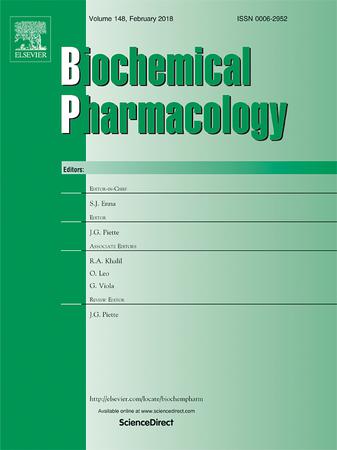Charged dendrimers reduce glioblastoma viability by modulating lysosomal activity and HMGB1-RAGE interaction
IF 5.6
2区 医学
Q1 PHARMACOLOGY & PHARMACY
引用次数: 0
Abstract
Dendrimers and dendrimer-based self-assembly systems have emerged as promising nanocarriers for a variety of applications, including anti-cancer therapies, modulation of the tumor microenvironment, and imaging. Here, we explored the therapeutic potential of two charged dendrimers, dendritic polyglycerol sulfate (dPGS) and dendritic polyglycerol amine (dPGA), in the context of glioblastoma multiforme (GBM). Docosahexaenoic acid (DHA) has shown potential in GBM. We therefore examined dPGS and dPGA effects alone and in combination with DHA. Using 2D cell models and 3D tumoroids, we showed that DHA with dPGA reduced tumor integrity and cell viability. dPGS reduced oxidative stress, whereas dPGA reduced lysosomal acidification, contributing to cellular dysfunction. Both dendrimers influence the interaction between high mobility group box 1 (HMGB1) and the receptor for advanced glycation end products (RAGE). The surfaces of the HMGB1-RAGE complex provide binding sites for interactions of charged molecules like dPGS and dPGA, suggesting the contribution of these interactions to cytotoxicity. In summary, our findings show that combining DHA with charged dendrimers (dPGS and dPGA) enhances GBM cytotoxicity through several mechanisms, involving lysosomal alkalinization, lipid peroxidation and modulation of the HMGB1-RAGE complex.

带电树状大分子通过调节溶酶体活性和HMGB1-RAGE相互作用降低胶质母细胞瘤的生存能力
树状大分子和基于树状大分子的自组装系统已经成为各种应用的有前途的纳米载体,包括抗癌治疗、肿瘤微环境调节和成像。在这里,我们探索了两种带电树突状聚甘油硫酸盐(dPGS)和树突状聚甘油胺(dPGA)在多形性胶质母细胞瘤(GBM)中的治疗潜力。二十二碳六烯酸(DHA)在GBM中显示出潜力。因此,我们检查了dPGS和dPGA单独和与DHA联合的作用。通过2D细胞模型和3D类肿瘤模型,我们发现DHA和dPGA降低了肿瘤的完整性和细胞活力。dPGS减少氧化应激,而dPGA减少溶酶体酸化,导致细胞功能障碍。两种树状大分子都影响高迁移率组盒1 (HMGB1)和晚期糖基化终产物受体(RAGE)之间的相互作用。HMGB1-RAGE复合物的表面为带电分子(如dPGS和dPGA)的相互作用提供了结合位点,提示这些相互作用对细胞毒性的贡献。总之,我们的研究结果表明,DHA与带电树突状大分子(dPGS和dPGA)结合可以通过溶酶体碱化、脂质过氧化和HMGB1-RAGE复合物的调节等多种机制增强GBM细胞毒性。
本文章由计算机程序翻译,如有差异,请以英文原文为准。
求助全文
约1分钟内获得全文
求助全文
来源期刊

Biochemical pharmacology
医学-药学
CiteScore
10.30
自引率
1.70%
发文量
420
审稿时长
17 days
期刊介绍:
Biochemical Pharmacology publishes original research findings, Commentaries and review articles related to the elucidation of cellular and tissue function(s) at the biochemical and molecular levels, the modification of cellular phenotype(s) by genetic, transcriptional/translational or drug/compound-induced modifications, as well as the pharmacodynamics and pharmacokinetics of xenobiotics and drugs, the latter including both small molecules and biologics.
The journal''s target audience includes scientists engaged in the identification and study of the mechanisms of action of xenobiotics, biologics and drugs and in the drug discovery and development process.
All areas of cellular biology and cellular, tissue/organ and whole animal pharmacology fall within the scope of the journal. Drug classes covered include anti-infectives, anti-inflammatory agents, chemotherapeutics, cardiovascular, endocrinological, immunological, metabolic, neurological and psychiatric drugs, as well as research on drug metabolism and kinetics. While medicinal chemistry is a topic of complimentary interest, manuscripts in this area must contain sufficient biological data to characterize pharmacologically the compounds reported. Submissions describing work focused predominately on chemical synthesis and molecular modeling will not be considered for review.
While particular emphasis is placed on reporting the results of molecular and biochemical studies, research involving the use of tissue and animal models of human pathophysiology and toxicology is of interest to the extent that it helps define drug mechanisms of action, safety and efficacy.
 求助内容:
求助内容: 应助结果提醒方式:
应助结果提醒方式:


